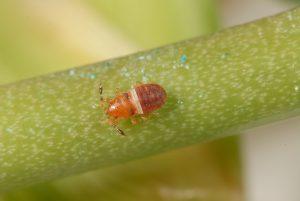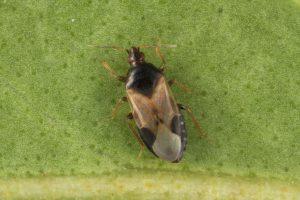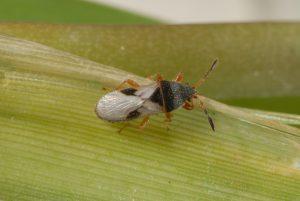For the Commercial Horticulture Audience:
The southern chinch bug, Blissus insularus, is the most damaging insect pest of St. Augustinegrass.
They tend to strike when turf is stressed by drought conditions in spring to summer. However, I have found them active in the winter months when we get heat waves, so don’t assume a damaged spot is fungus. To scout and monitor for the insect there are a few options. The most common is the visual inspection of leaf blades, stolons, or thatch to look for the active adults or the tiny red nymphs as shown in figure 1. There is also the option to use a handheld vacuum cleaner or leaf blower with airflow reversed and a mesh bag. Dump the contents of the containers onto a light-colored surface to search for moving insects. You can also use the flotation technique. In the flotation technique you take an impermeable cylinder that is open on both ends and push it 2-3 inches into the soil on the edge of healthy turf. Then slowly fill the cylinder with water and count the number of chinch bugs that float to the surface within 5 minutes. You may have to continue to pour in water to keep the waterline above the turf. If no chinch bugs appear on the first run, try 3 or 4 other areas on the damaged edge. One thing to keep in mind while performing this scouting is that you want to properly identify the chinch bugs. In Fig. 2, you can see how similar a beneficial insect, the minute pirate bug, looks like an adult chinch bug (Fig. 3). The easiest way to identify chinch bugs is if you have an adult and the red nymphs (Fig. 1 )

Post-inspection Management
After determining that there is an active infestation and that the damage is not caused by a fungal infection or some other factor, it is now time for treatment. Most pest management professionals rely on seasonal, preventative, cover spray applications with pyrethroids. This can lead to issues with pesticide resistance in chinch bugs. Pesticide resistance occurs when an insecticide kills a portion of the population, but some are able to survive and reproduce. Those that were able to survive have now passed on whatever genes made them resistant to that class of insecticide resulting in a higher population of resistant individuals that will survive the next application of the same insecticide. Chinch bugs have developed resistance to pyrethroids, neonicotinoids, organochlorines, and organophosphates from repeated exposure to these classes of insecticides. This is why it is so important to rotate insecticides with different modes of action. (For more, please consult, Managing Insecticide and Miticide Resistance in Florida Landscapes).

Credit: Lyle Buss, UF/IFAS

Currently UF/IFAS recommends the use of a thorough application of systemic insecticides for control of southern chinch bugs. This is due to non-target organism effects of contact sprays, the need for direct contact with contact sprays, and longer lasting control. Systemic insecticides are taken up by the plant and ingested upon feeding. This allows for biological control from predators in between applications. Systemics also have longer residual activity. One concern is that systemic insecticides like neonicotinoids are harmful to pollinators. However, if the label is followed properly, this is not a concern. Always follow the label. If you feel that you are running into issues with resistance and need help with an insecticide rotation feel free to reach out at wrgator@ufl.edu. For cultural control recommendations to customers in St. Augustinegrass click here!
 4
4
